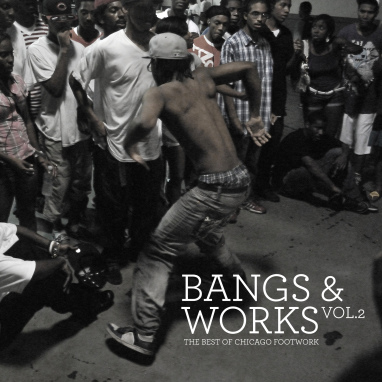If footwork ever goes on to prove as influential as dubstep, the first Bangs & Works will be recognised as its Run The Road, its Dubstep Allstars – the definitive compilation that brought the genre out of its own hyper-localised scene and under the wider global radar. Mike Paradinas’ original haul has made minor stars of hitherto unknown DJ/producers such as Roc, Spinn and Rashad, all of whom have released solo efforts on Paradinas’ UK electronica label Planet-μ. Twelve months since its release, and we’ve already seen the likes of Africa Hitech, Machinedrum and Sully paying tribute to Bangs & Works‘ 160bpm sample-splitting madness, to great effect in most cases.
Influential? Certainly. Accessible? Mmm, well… Footwork was never initially intended to be heard away from the ferocious dance circles formed in Chicago basements and gyms, far from our own home stereos and iPods. The music’s primary function as a backdrop for dance battles has seen even devoted followers owning up to aural exhaustion through extended play. The style’s frenetic rhythms and homespun productions sound erratic and alien in mainstream club and home listening environments.
But this is precisely why footwork has garnered a niche audience grown weary of rising production values. There’s an honesty, a rawness, a "punk rock-ness" inherent in footwork that hasn’t really been heard since the early years of techno and its more extreme offshoots like gabba and ‘ardkore. Global adopters like Africa Hitech and Addison Groove have found success through re-appropriation of the footwork template, bevelling its rough edges and cutting it with other styles of dance and electronica. But Bangs & Works‘ legacy so far has been a backboard to be bounced off – an interesting and inspiring artefact to be drawn from, twisted and bastardised at will, but not necessarily played (in its purest form) for pleasure alone. Footwork remains a largely academic pursuit for many listeners, yet to spawn a big Fabric mix or a major clubbing scenario. So after Bangs & Works, how much OG footwork do we really need? And does anyone seriously need to own more than one footwork album?
Bangs & Works Vol. 2 makes a very good case for the affirmative. Maybe it’s something to do with time, having allowed the footwork sound to sink in over the last year, but to these ears this second volume feels like a remarkable step-up from the first outing. Whereas Vol. 1 set out to showcase footwork in its essence, Vol. 2 is all the better off for exploring the style’s outer limits. Still as unhinged as ever, the variety on show makes for a much more accessible listening experience.
Here, it’s all about the twists and turns – the bluffs and dummies incorporated into footwork production that trip and wrongside dancers into having to think "on their feet". Scene originator RP Boo claims the first footwork rhythm was programmed in about five-minutes. He opens this compilation with ‘Heavy Heat’ – no more than a hotch-potch of incongruous sounds, with the odd 808 snare thrown in to keep it all from falling apart. For all it’s worth, it could just be the intro from Pharoahe Monch’s ‘Simon Says’ skipping on a malfunctioning CD player. But as the disparate snippets of vocal and siren build up around one another, they start to form a semi-logical pattern, hinting at something greater than the sum of its parts. There’s a looseness in the footwork template that allows for an almost free-jazz aesthetic – where snares don’t have to hit on every third beat and samples are broken and retriggered so many times over that they form their own unique linguistic framework.
Longtime player Traxman is so hasty in his stream-of-consciousness mixing and matching of samples that the chopped eighties loop on ‘Brainwash’ contains noticeable gaps that are way too big and sloppy to be accidental. Instead they create a disorientating stop-start effect that tricks the brain (and supposedly dancers’ feet) into believing there’s something wrong with the music; that is, until the whole thing ramps up about three notches and goes absolutely berserk in the last third.
DJ T-Why, a newcomer to the series, manages to marry the classic ESG ‘UFO’ sample with a string arrangement from Lord Of The Rings. Why? Because he can. And because people need new beats to dance to.
There really are too many WTF moments on this compilation to mention – and that, if nothing else, is the reason you should own it. It’s been too long since any new music has been this unabashedly goddamn brave about not sugarcoating itself in shimmering production or reining itself in with uptight pop sensibilities. Bangs & Works Vol. 2 straddles a fine line between function and dysfunction, innocence and dissonance – and not once in its 26 track run does it ever get boring.


